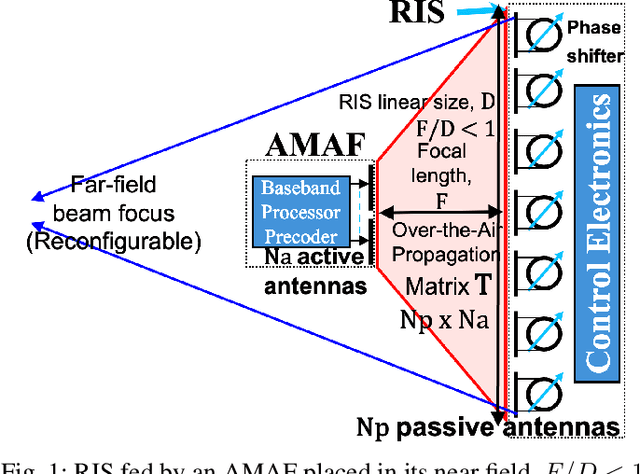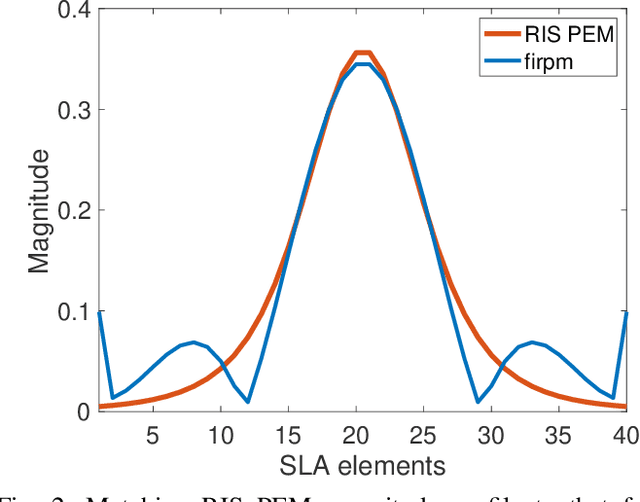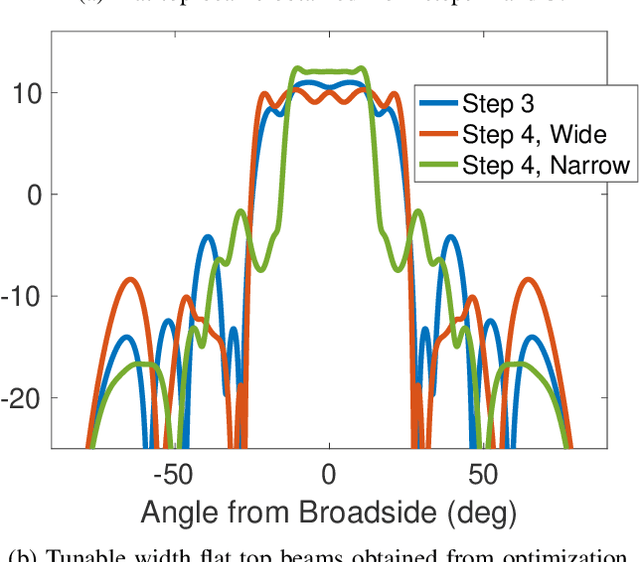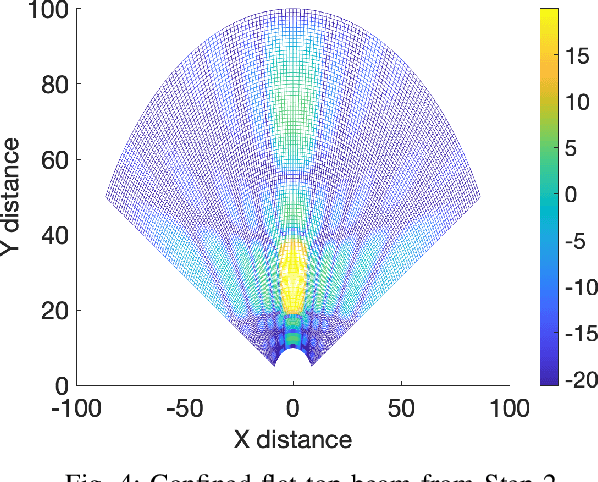Krishan Kumar Tiwari
Array-Fed RIS: Validation of Friis-Based Modeling Using Full-Wave Simulations
Feb 13, 2025



Abstract:Space-fed large antenna arrays offer superior efficiency, simplicity, and reductions in size, weight, power, and cost (SWaP-C) compared to constrained-feed systems. Historically, horn antennas have been used for space feeding, but they suffer from limitations such as bulky designs, low aperture efficiency ($\approx 50\%$), and restricted degrees of freedom at the continuous aperture. In contrast, planar patch arrays achieve significantly higher aperture efficiency ($>90\%$) due to their more uniform aperture distribution, reduced weight, and increased degrees of freedom from the discretized aperture. Building on these advantages, we proposed an array-fed Reflective Intelligent Surface (RIS) system, where an active multi-antenna feeder (AMAF) optimizes power transfer by aligning with the principal eigenmode of the AMAF-RIS propagation matrix $\mathbf{T}$. While our previous studies relied on the Friis transmission formula for system modeling, we now validate this approach through full-wave simulations in CST Microwave Studio. By comparing the Friis-based matrix, $\mathbf{T}_{\rm Friis}$, with the full-wave solution, $\mathbf{T}_{\rm full$.$wave}$, we validate the relevance of the Friis-based modeling for top-level system design. Our findings confirm the feasibility of the proposed AMAF-RIS architecture for next-generation communication systems.
Flat-Top Beamforming with Efficient Array-Fed RIS
Feb 12, 2025



Abstract:Flat-top beam designs are essential for uniform power distribution over a wide angular sector for applications such as 5G/6G networks, satellite communications, radar systems, etc. Low sidelobe levels with steep transitions allow negligible cross sector illumination. Active array designs requiring amplitude taper suffer from poor power amplifier utilization. Phase only designs, e.g., Zadoff-Chu or generalized step chirp polyphase sequence methods, often require large active antenna arrays which in turns increases the hardware complexity and reduces the energy efficiency. In our recently proposed novel array-fed reflective intelligent surface (RIS) architecture, the small ($2 \times 2$) active array has uniform (principal eigenmode) amplitude weighting. We now present a pragmatic flat-top pattern design method for practical array (RIS) sizes, which outperforms current state-of-the-art in terms of design superiority, energy efficiency, and deployment feasibility. This novel design holds promise for advancing sustainable wireless technologies in next-generation communication systems while mitigating the environmental impact of high-energy antenna arrays.
A Modular Pragmatic Architecture for Multiuser MIMO with Array-Fed RIS
May 01, 2024Abstract:We propose a power- and hardware-efficient, pragmatic, modular, multiuser/multibeam array-fed RIS architecture particularly suited to operate in very high frequency bands (high mmWave and sub-THz), where channels are typically sparse in the beamspace and line-of-sight (LOS) is required to achieve an acceptable received signal level. The key module is an active multi-antenna feeder (AMAF) with a small number of active antennas placed in the near field of a RIS with a much larger number of passive controllable reflecting elements. We propose a pragmatic approach to obtain a steerable beam with high gain and very low sidelobes. Then, $K$ independently controlled beams can be achieved by stacking $K$ of such AMAF-RIS modules. Our analysis takes in full account: 1) the near-end crosstalk (NEXT) between the modules, 2) the far-end crosstalk (FEXT) due to the sidelobes; 3) a thorough energy efficiency comparison with respect to conventional {\em active arrays} with the same beamforming performance. Overall, we show that the proposed architecture is very attractive in terms of spectral efficiency, ease of implementation (hardware complexity), and energy efficiency.
A New Old Idea: Beam-Steering Reflectarrays for Efficient Sub-THz Multiuser MIMO
Dec 04, 2023Abstract:We present a novel, power- & hardware-efficient, multiuser, multibeam RIS (Reflective Intelligent Surface) architecture for multiuser MIMO, especially for very high frequency bands (e.g., high mmWave and sub-THz), where channels are typically sparse in the beamspace and LOS is the dominant component. The key module is formed by an active multiantenna feeder (AMAF) with a small number of active antennas, placed in the near field of a RIS with a much larger number of passive controllable reflecting elements. We propose a pragmatic approach to obtain a steerable beam with high gain and very low sidelobes. Then K independently controlled beams can be achieved by closely stacking K such AMAF-RIS modules. Our analysis includes the mutual interference between the modules and the fact that, due to the delay difference of propagation through the AMAF-RIS structure, the resulting channel matrix is frequency selective even for pure LOS propagation. We consider a 3D geometry and show that "beam focusing" is in fact possible (and much more effective in terms of coverage) also in the far-field, by creating spotbeams with limited footprint both in angle and in range. Our results show that: 1) simple RF beamforming (BF) without computationally expensive baseband multiuser precoding is sufficient to practically eliminate multiuser interference when the users are chosen with sufficient angular/range separation, thanks to the extremely low sidelobe beams; 2) the impact of beam pointing errors with standard deviation as large as 2.5 deg and RIS quantized phase-shifters with quantization bits > 2 is essentially negligible; 3) The proposed architecture is more power efficient & much simpler from a hardware implementation viewpoint than standard active arrays with the same BF performance. We show also that the array gain of the proposed AMAF-RIS structure is linear with the RIS aperture.
Power Transfer between Two Antenna Arrays in the Near Field
Jul 31, 2023Abstract:This letter presents numerical results with a focus on power transfer between two antenna arrays placed in the near field, where a much smaller active multi-antenna feeder (AMAF) center feeds a far larger passive array referred to as a reflective intelligent surface (RIS). The AMAF is configured along the principal eigenmode of the AMAF-RIS propagation matrix T. The interest is in the regime of f/D less than unity. The power transfer coefficient deviates from the classical distance dependent inverse square law model. This is due to the natural taper across the RIS aperture at such small f/D ratios. In addition, the behavior of the power transfer coefficient is more sensitive to the f/D ratio than to a specific RIS size. We also see that the center feed is more power efficient than end feed.
 Add to Chrome
Add to Chrome Add to Firefox
Add to Firefox Add to Edge
Add to Edge